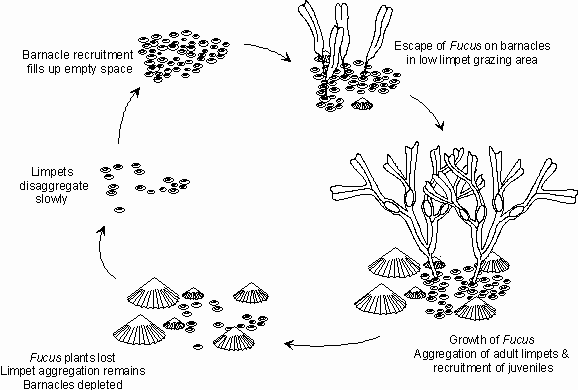| |
Dynamics of populations and communities
The general patterns of zonation on rocky shores can be explained in terms of physical
factors affecting the outcome of biological interactions. However, even clearly delimited
zones of conspicuous space occupiers or canopy forming seaweeds also consist of numerous
subsidiary species, the populations of which undergo fluctuations in space and time.
Sheltered rocky shores generally have vary stable patterns of zonation over time. This can
be true of steeper moderately exposed shores. Flatter moderately exposed shores are often
characterised by highly dynamic communities with patches of one species giving way to
another over time (see below). Communities on very exposed shores show dynamics caused by physical
disturbance events which create space for recolonization.
Many fluctuations seen in rocky shore communities are due to biological
interactions. However, all ecological communities are influenced to some degree by
physical factors. The interaction of the emersion gradient, the wave exposure gradient and
disturbance regime, the local hydrodynamic regime and the geographical position of the
shore determine which species are likely to be found there. Thus any effect of species
interactions (grazing, predation or competition) on community structure may ultimately
depends on the influence of the physical environment on the species involved.
Stochastic (chance) events contribute greatly to variability in the community. The
major cause of this type of variability is stochastic variation in the supply of
settling planktonic propagules of key species in the community (Hawkins and Hartnoll,
1982; Gaines and Roughgarden, 1985; Hartnoll and Hawkins, 1985; Gaines and Bertness, 1992;
see section E below), but the disturbance due to major climatic events (e.g. Crisp, 1964)
or small-scale physical damage (Paine and Levin, 1981; Shanks and Wright, 1986) can have
important effects.
Biologically-generated
patches on moderately exposed shores
Moderately exposed rocky shores are often made up of a mosaic of patches, each cycling
through a number of successional stages (Figure 5) and structured by a number of
positive and negative interactions between the main species but with fluctuations
generated by recruitment variation. The community is composed of such patches, each
dominated by a particular species or group of species, which may give way to others and
sometimes to bare rock over time. These have been particularly well studied on the Isle of
Man (Burrows and Lodge, 1950; Hawkins and Hartnoll, 1983; Hartnoll and Hawkins; 1985,
reviewed by Hawkins et al., 1992). The limpet Patella vulgata is an
important grazer, feeding on the young Fucus vesiculosus plants. Mature F.
vesiculosus plants dislodge settling barnacles, Semibalanus balanoides as their
fronds sweep over the rock. Juvenile limpets, which dislodge newly settled barnacles as
they move, and dogwhelks, which are predators of barnacles, aggregate under mature clumps
of F. vesiculosus. Thus, barnacles are scarce in patches dominated by mature F.
vesiculosus; however, these patches last for only about 3 to 4 years. The sweeping
action of F. vesiculosus fronds and the presence of limpets minimises the
successful settlement of young fucoids. When the old plants die back, the sheltering
limpets disperse and the bare rock is then colonised by barnacles. Limpet grazing is
inefficient amongst mature barnacles; as a result, some fucoids are able to settle and
survive. F. vesiculosus clumps appear amongst the barnacles, reducing barnacle
recruitment and encouraging the aggregation of limpets.

Next Section
References
|

